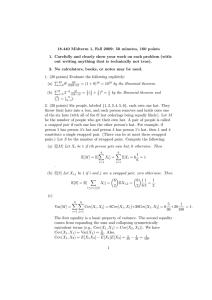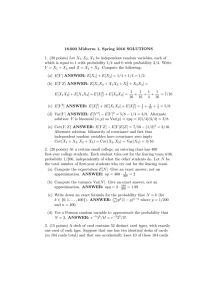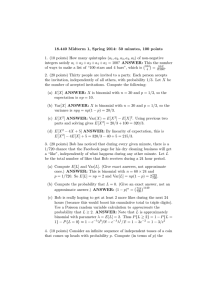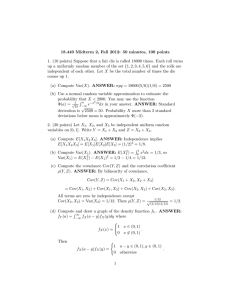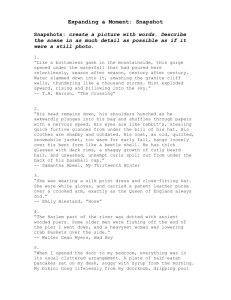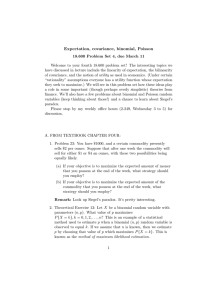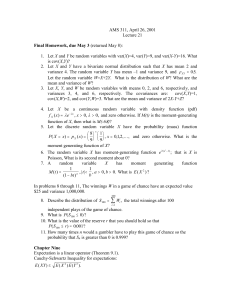18.440 Midterm 1, Fall 2009: 50 minutes, 100 points
advertisement
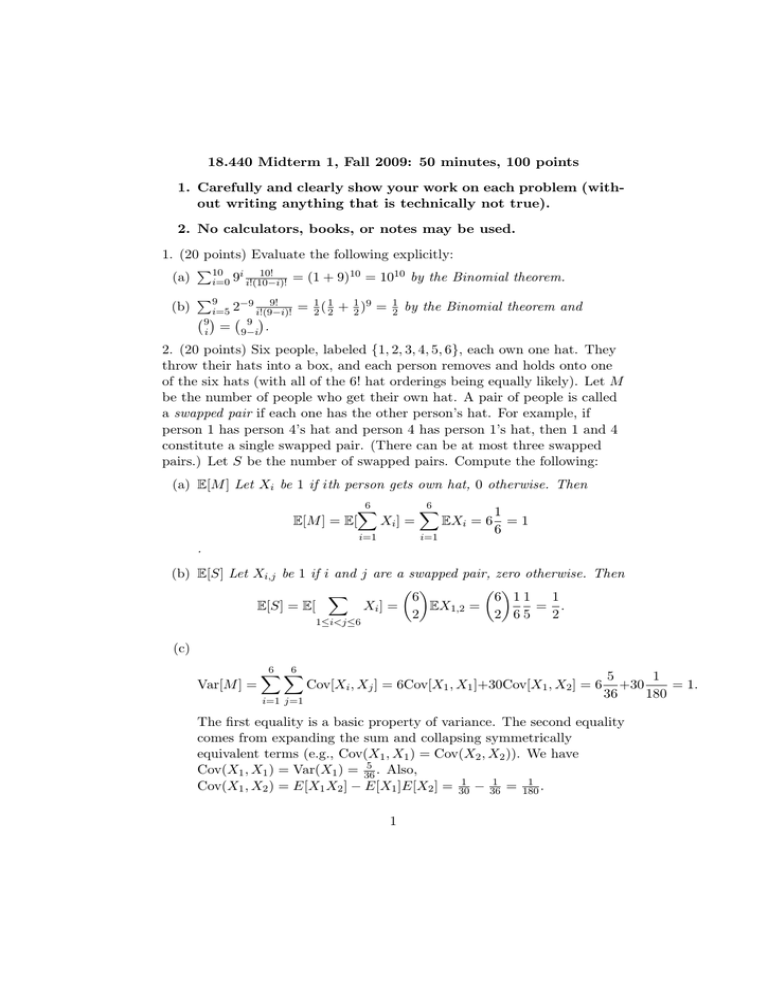
18.440 Midterm 1, Fall 2009: 50 minutes, 100 points
1. Carefully and clearly show your work on each problem (without writing anything that is technically not true).
2. No calculators, books, or notes may be used.
1. (20 points) Evaluate the following explicitly:
P10 i 10!
10 = 1010 by the Binomial theorem.
(a)
i=0 9 i!(10−i)! = (1 + 9)
(b)
P9
9!
1 1
1 9
−9
i=5 2
i!(9−i)! = 2 ( 2 + 2 ) =
9
9
i = 9−i .
1
2
by the Binomial theorem and
2. (20 points) Six people, labeled {1, 2, 3, 4, 5, 6}, each own one hat. They
throw their hats into a box, and each person removes and holds onto one
of the six hats (with all of the 6! hat orderings being equally likely). Let M
be the number of people who get their own hat. A pair of people is called
a swapped pair if each one has the other person’s hat. For example, if
person 1 has person 4’s hat and person 4 has person 1’s hat, then 1 and 4
constitute a single swapped pair. (There can be at most three swapped
pairs.) Let S be the number of swapped pairs. Compute the following:
(a) E[M ] Let Xi be 1 if ith person gets own hat, 0 otherwise. Then
E[M ] = E[
6
X
Xi ] =
i=1
6
X
i=1
1
EXi = 6 = 1
6
.
(b) E[S] Let Xi,j be 1 if i and j are a swapped pair, zero otherwise. Then
X
1
6
6 11
E[S] = E[
= .
Xi ] =
EX1,2 =
2
2 65
2
1≤i<j≤6
(c)
Var[M ] =
6 X
6
X
Cov[Xi , Xj ] = 6Cov[X1 , X1 ]+30Cov[X1 , X2 ] = 6
i=1 j=1
5
1
+30
= 1.
36
180
The first equality is a basic property of variance. The second equality
comes from expanding the sum and collapsing symmetrically
equivalent terms (e.g., Cov(X1 , X1 ) = Cov(X2 , X2 )). We have
5
. Also,
Cov(X1 , X1 ) = Var(X1 ) = 36
1
1
1
− 36
= 180
.
Cov(X1 , X2 ) = E[X1 X2 ] − E[X1 ]E[X2 ] = 30
1
3. (20 points) Let D1 and D2 be the outcomes (in {1, 2, 3, 4, 5, 6}) of two
independent fair die rolls. Let Yi be the random variable which is equal to
1 if D1 = i and 0 otherwise. Compute the following:
2
(a) E[D12 D22 ] = E[D12 ]E[D22 ] = (91)
36 =
91
EDi2 = 1+4+9+16+25+36
=
6
6 .
8281
6
by independence and
(b) Var[D1 − D2 ] = Var[D1 ] + Var[D2 ] − 2Cov[D1 , D2 ] = 2Var[D1 ] =
35
6 .
(c) Cov(Y1 + Y2 + Y3 , Y5 + Y6 ) = 6Cov[Y1 , Y5 ] = − 61 by bilinearity of
covariance.
P
(d) Var[ 6i=1 Yi ]. The sum is constant, so the variance is zero.
4. (20 points) Let X1 , X2 , and X3 be independent Poissonian random
variables with parameters λ1 = 1, λ2 = 2, λ3 = 3, respectively. Compute
the probabilities of the following events:
(a) The largest of X1 , X2 , and X3 is at least 1. One minus the
probability they are all zero is 1 − e−λ1 e−λ2 e−λ3 = 1 − e−6 .
(b) The largest of X1 , X2 , and X3 is exactly 1. The probability that each
Xi is 1 or 0 is
3
3
Y
Y
−λ1 λ2 λ3
−λi
−λi
+ λi e ) = e
(1 + λi ) = 24e−6 .
(e
i=1
i=1
Subtracting the probability that the Xi are all zero yields 23e−6 .
5. (20 points) There are ten children: five attend school A, three attend
school B, and two attend school C. Suppose that a pair of two children is
chosen uniformly at random from the set of all possible pairs of children.
Let a be the number of students in the random pair that attend school A
and let b be the number in the pair that attend school B. (So both a and b
take values in the set {0, 1, 2}.)
(a) Compute E[ab]. Product will be non-zero (and equal to 1) only if
a = b = 1. The expectation is the probability of this: 15
= 31 .
(10
2)
(b) Given that the two children in this pair attend the same school, what
is the conditional probability that they both attend school A?
5
10
5
2
5
3
2 = 14 = 7 .
2 + 2 + 2
2
